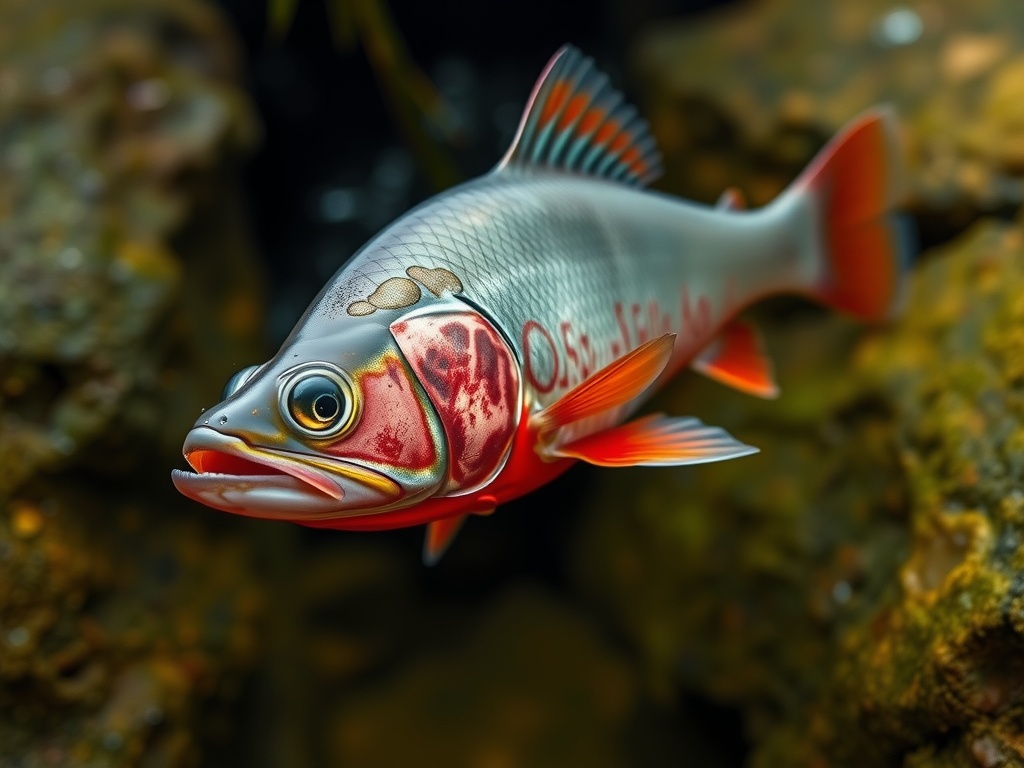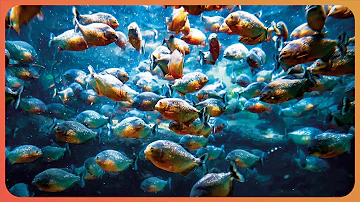
Red-bellied Piranha
Pygocentrus nattereri

Meet the Red-bellied Piranha
The red-bellied piranha is a medium-sized, freshwater fish renowned for its powerful jaws and sharp, triangular teeth. Native to South American rivers, particularly the Amazon Basin, these fish are often associated with their aggressive feeding behavior, though they are typically shy and prefer to travel in schools for protection. Red-bellied piranhas have silvery bodies with a reddish tinge on the belly, especially pronounced in adults. Though their fearsome reputation is somewhat exaggerated, they play a crucial role in their ecosystem by consuming weak or dead animals and maintaining balance in aquatic environments.
Classification
Fish
Habitat
Freshwater rivers and lakes
Diet
Omnivore
Lifespan
4-10 years
Conservation
Least Concern
Weight
0.5–1.5 kg
📖Fascinating Facts
Powerful Bite
Red-bellied piranhas have one of the strongest bites among bony fish relative to their size, capable of easily slicing through flesh and bone.
Schooling Behavior
They often swim in schools of 20 or more individuals, which helps them defend against predators and increases their chances of finding food.
Habitat Adaptability
Piranhas can thrive in a wide range of freshwater environments, including slow-moving rivers, floodplains, and lakes throughout the Amazon and other South American river systems.
📋Detailed Description
The red-bellied piranha (Pygocentrus nattereri) is a robust, laterally compressed fish reaching lengths of 20–33 cm (8–13 in), with some individuals recorded up to 50 cm in the wild. Adults display a striking red or orange coloration on the lower jaw, throat, and belly, contrasting with their silvery flanks and darker dorsal surface. Their most distinctive anatomical feature is a single row of sharp, triangular, interlocking teeth, perfectly adapted for shearing flesh. The head is broad with a pronounced lower jaw, giving them a powerful bite force relative to body size—measured at up to 320 N (newtons) in large specimens. The eyes are large and positioned laterally, aiding in wide-field vision. Red-bellied piranhas are highly social, forming shoals of 20–100 individuals, which serve primarily as a defense against predators rather than for cooperative hunting. Their behavior is generally cautious and secretive, with peak activity during dawn and dusk (crepuscular). Acoustic communication is well developed, with individuals producing a series of grunts, croaks, and drum-like sounds during social interactions, particularly in aggressive or territorial contexts. They are opportunistic omnivores, feeding on a wide range of animal and plant matter, including fish, insects, crustaceans, seeds, and fruits. Spawning occurs seasonally, triggered by rising water levels during the rainy season, and involves complex courtship and nest-building behaviors. Eggs are adhesive and deposited in shallow, vegetated areas, with both parents often guarding the nest. Juveniles exhibit rapid growth, reaching sexual maturity within 1–2 years. The species plays a vital ecological role as both predator and scavenger, helping regulate fish populations and recycle nutrients in their habitats.
💡 Did you know?
Red-bellied piranhas are more likely to scavenge than to attack live prey, and large feeding frenzies usually occur only when food is scarce.
🔬Research & Sources
Wikipedia Summary
The red-bellied piranha, also known as the red piranha, is a type of piranha native to South America, found in the Amazon, Paraguay, Paraná and Essequibo basins, as well as coastal rivers of northeastern Brazil. This fish is locally abundant in its freshwater habitat. They are omnivorous foragers and feed on insects, worms, crustaceans, and fish. They are not a migratory species but do travel to seek out conditions conducive to breeding and spawning during periods of increased rainfall. Red-bellied piranhas often travel in shoals as a predatory defense but rarely exhibit group hunting behavior. Acoustic communication is common and is sometimes exhibited along with aggressive behaviors. They are a popular aquarium fish.
Last Modified: 5/25/2025
🎭Behavior & Social Structure
Red-bellied piranhas exhibit a combination of solitary and group behaviors. While often depicted as aggressive, they are generally shy and avoid unnecessary confrontation, relying on shoaling as a primary anti-predator strategy. Within shoals, a loose dominance hierarchy exists, with larger, more aggressive individuals asserting priority during feeding. Feeding frenzies, though rare, can occur when food is scarce or when a large prey item is encountered, leading to rapid, coordinated attacks. Most of the time, individuals forage independently within the group, targeting insects, small fish, or carrion. Piranhas communicate using a repertoire of acoustic signals—such as barks, grunts, and thuds—produced by rapid contraction of sonic muscles attached to the swim bladder. These sounds mediate social spacing, aggression, and reproductive interactions. Daily activity peaks at dawn and dusk, with individuals seeking shelter among submerged roots or dense vegetation during midday to avoid predators and high temperatures.
👶Reproduction & Life Cycle
Breeding in Pygocentrus nattereri is closely linked to the onset of the rainy season (typically November to March, varying by region), which triggers migration to flooded forests and shallow marginal areas. Courtship involves synchronized swimming and circling displays, with males preparing and defending small depressions in the substrate as nests. Females lay between 1,000 and 5,000 adhesive eggs per spawning event, which are fertilized externally. Both parents may guard the nest, fanning eggs to ensure oxygenation and warding off potential egg predators. Incubation lasts 2–3 days, after which larvae remain in the nest for several more days, absorbing their yolk sacs before dispersing. Juvenile piranhas form tight schools for protection and exhibit rapid growth, reaching sexual maturity at approximately 12–18 months under optimal conditions.
🛡️Adaptations & Survival
Red-bellied piranhas possess several key adaptations for survival in dynamic riverine environments. Their powerful jaws and razor-sharp, replaceable teeth enable them to efficiently process a variety of prey, including tough-scaled fish and hard-shelled invertebrates. The laterally compressed body allows for agile maneuvering among submerged roots and dense aquatic vegetation. Shoaling behavior reduces individual predation risk and facilitates information sharing about food sources. Their acute sense of smell and lateral line system allow them to detect injured or distressed prey from considerable distances. The ability to produce and interpret acoustic signals is a unique adaptation among characiform fishes, supporting complex social interactions. Physiologically, they tolerate wide fluctuations in water temperature, oxygen levels, and turbidity, reflecting the variable conditions of South American floodplain rivers.
🎨Cultural Significance
Red-bellied piranhas hold a prominent place in South American folklore and popular culture, often portrayed as fearsome predators capable of stripping large animals to the bone in minutes—a reputation largely exaggerated by early explorers and sensational media. In indigenous cultures, piranha teeth have been used as tools and weapons, and the fish itself is sometimes consumed as food. The species is a popular exhibit in public aquaria worldwide and is occasionally kept by hobbyists, though it requires specialized care. Piranhas also serve as a symbol of the Amazon's biodiversity and are frequently referenced in literature, film, and art.
🔬Recent Research & Discoveries
Recent research has focused on the biomechanics of the piranha bite, revealing one of the strongest bite forces among bony fishes relative to body size. Studies of their acoustic communication have uncovered a sophisticated system of sound production and interpretation, unique among freshwater fishes. Genetic analyses have clarified the evolutionary relationships within the Serrasalmidae family, supporting the distinction of Pygocentrus nattereri from closely related species. Ongoing ecological studies are examining the role of piranhas in nutrient cycling and their responses to environmental changes, such as habitat fragmentation and climate variability. There is also interest in the potential use of piranha-derived compounds for biomedical applications, given their robust immune systems.
🎥Wildlife Videos

Vicious Piranha Moments | BBC Earth
Welcome to BBC EARTH! The world is an amazing place full of stories, beauty and natural wonder. Here you'll find 50 years worth ...
BBC Earth

Red-Bellied Piranhas 🐡 | Amazing Animals
About Amazing Animals: Amazing Animals is a series that profiles a different animal in each episode. These short, one-minute ...
Nat Geo Kids

The Piranha Infested Waters Of The Amazon | WILD 24 | Real Wild
Explore the untamed beauty of Brazil's diverse wildlife in this captivating documentary. Witness the daily struggles and survival ...
Real Wild

Piranha Feeding Frenzy | Planet Earth | BBC Earth
Taken From Planet Earth Series 1, Episode 3 WATCH MORE: New on Earth: https://bit.ly/2M3La96 Oceanscapes: ...
BBC Earth

The Truth About the Red-Bellied Piranha @CLEAquarium
Are piranhas as fierce as they're often made out to be in pop culture? Maggie H. dispels some of the myths and tells you how ...
Greater Cleveland Aquarium (cleaquarium)

Killer Instincts: Piranha Wolf In The Water Wild Animal Documentary
Since 90% of what we know about piranhas today is hype, it's nice to see a publicly available video that's mostly true. Almost all ...
Mariusz A
🌍Habitat Information
The Red-bellied Piranha typically inhabits Freshwater rivers and lakes environments. Red-bellied Piranhas have adapted to their environments with specialized features and behaviors.
Primary Habitat:
Freshwater rivers and lakes
More detailed habitat information will be available soon.
🛡️Conservation Status
The Red-bellied Piranha is currently classified as Least Concern. Conservation efforts are crucial for preserving this species for future generations.
Common Threats:
- 🏠Habitat loss and fragmentation
- 🌡️Climate change impacts
- 🎯Hunting and poaching
- 🏭Human-wildlife conflict
⚠️Threats & Conservation Challenges
Currently assessed as Least Concern by the IUCN, red-bellied piranhas remain widespread and locally abundant. However, localized threats include habitat degradation due to deforestation, dam construction, and water pollution, which can alter spawning grounds and reduce prey availability. Overfishing for the aquarium trade and as a food source in some regions may impact certain populations. Misconceptions about their danger have led to culling campaigns and legal restrictions in some countries, though such measures are rarely justified ecologically. Climate change poses a long-term threat by altering hydrological cycles and potentially disrupting breeding patterns. Despite these challenges, the species demonstrates considerable ecological resilience.
🔬Scientific Classification
Scientific Name
Pygocentrus nattereri
Classification Hierarchy
🔍 About Taxonomic Classification
Taxonomic classification is a hierarchical system used by scientists to classify and organize living organisms based on shared characteristics and evolutionary relationships.
The system moves from broad categories (Kingdom) to increasingly specific ones, with each animal's scientific name typically consisting of its Genus and species.
📝Community Notes
Share your observations and insights about the Red-bellied Piranha with our community of wildlife enthusiasts.
Join Our Community
Sign in to share your observations and connect with fellow wildlife enthusiasts.
Sign In to ContributeNo community notes yet
Be the first to share your observations about the Red-bellied Piranha!
Explore Red-bellied Piranha
Select a tab above to learn more about this amazing animal.
📸Photo Gallery
No photos available for this animal yet.
🌟Discover More Wildlife
Continue your journey of discovery with more fascinating animals from our database
